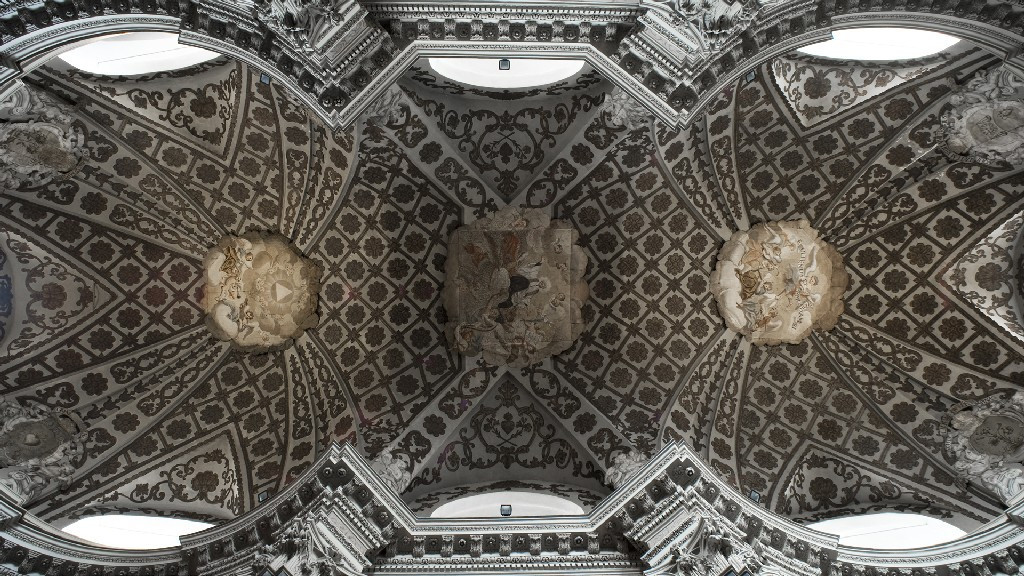Guarino Guarini
Guarino Guarini ( born January 7, 1624 Modena, † March 6, 1683 in Milan ) was an Italian mathematician, philosopher and important architect of the late baroque or of Sicilian Baroque.
Life
Guarino Guarini resigned in September 1639 to the Order of Theatines in Modena in; his superiors sent him to Rome, where he studied theology, philosophy, mathematics and architecture. 1647 Guarini returned back to Modena and was ordained a priest on January 17, 1648. On March 9, 1648, he was an economist and manager of economic and financial affairs of the Theatines in Modena.
In 1650 Guarini was appointed treasurer of the Order, with this post appeared, the first problems. On April 19, 1650 false items in the accounts was discovered by the Provost of the Order, in suspicion was Eugenio Guarini, the brother of Guarino Guarini. Guarino made up for the shortfall, the disputes were declared on November 20, 1650 by the General Board of the Theatines over. However, the relationship between the abbot and the brothers Guarini was hooked ever since. Guarino was appointed in 1650 lecturer in philosophy, Eugenio in 1653 to Procuratore. 1654 left Eugenio Modena to teach philosophy at Ferrara. The vacancy took over on May 30, 1654 Guarino Guarini. A little later, Guarino was 31 at the time, he was elected head of the Theatinerstrasse Order in Modena.
The election of the head of the Order, however, marked the beginning of a dispute with Alfonso d' Este, the IV, the Bernardo Castagnini preferred for this position and this repeatedly openly told the Theatinerstrasse Order. By letter dated February 25, 1655 of the Supreme General of the Order of Alfonso IV d'Este was this communicated that Guarino Guarini had covered his position as chief. The Theatines in Modena remained for over a year without head, 1656, they chose then the Executive Board, wanted Alfonso: Bernardo Castagnini. This remained until his death on September 14, 1658 in this office. On September 9, 1658 Guarino was taken from Theatinerstrasse Order in Parma.
The return to Modena was often denied, even 14 years after his exit from Modena, he was still not welcome. From records show that he returned in 1657 still in his home town for a short stay. Then is first found in 1660 again an entry about his whereabouts since he appeared in Messina. The years 1657-1660 are also known as the "blank years" or referred to as a journeyman years, as it is not backed up, where Guarini was staying. The research suggested him either in Lisbon, Paris or Prague. After Meek is a stay on the Iberian Peninsula is most likely because Guarini could bring Islamic elements, which then appeared in his buildings in France, Italy (eg at San Lorenzo in Turin) and Lisbon.
For the following years 1660-1662 stays in Modena, Messina or Paris can be detained. 1660, the Church of the Santissima Annunziata was built in Messina, which was destroyed in 1908. By the 1660s Guarini also began his literary work.
1666 was Guarini in Turin down and took on its construction activities for the House of Savoy. It created a number of churches and other structures (eg, Palazzo Carignano ). Guarino Guarini in 1679 commissioned by Maria Giovanna di Savoia - Nemours to build the San Filippo Neri church, but he died at the beginning of the work, on March 6, 1683 in Milan.
His architectural works were influenced by the ideas of Francesco Borromini, which dealt especially with complicated intersections of architectural elements. Thus, the Palazzo Carignano has numerous parallels to Borromini's San Carlo alle Quattro Fontane in Rome. The influence of Moorish architecture is present.
Guarini was a major champion of the Italian late Baroque in Northern Italy, where he was active primarily in Turin for the House of Savoy from 1666. Here his main works were written. His buildings are lavishly designed with rich decor.
His writings Placita Philosophica ( 1665), Euclides Adauctus ( 1671) and Architettura Civile (1686) take a leading role in the matter of descriptive geometry. The latter work, published posthumously, also includes a commitment to the Gothic, as it finds itself transformed into its Turin 's San Lorenzo church.
Works
Especially his works in Messina were significant:
However, he was later recalled to Turin, also there are significant works were written of him:
Works outside Italy were:
Pictures
Guarino Guarini: Palazzo Carignano in Turin (extension to time by Guarini )
Guarino Guarini: San Annunziata dei Teatini in Messina









